Peter Cawdron's Blog, page 20
October 13, 2012
Book Cover
MONSTERS is due for release on October 31 of this year, but I haven’t been able to settle on a cover yet and thought you might like to help choose one. Here’s the blurb for the novel.
The fallout from a passing comet carries a biological pathogen, not a virus or a living organism, just a collection of amino acids forming a simple helical structure, but one that causes animals to revert to the age of the mega-fauna, when monsters roamed Earth.
With the collapse of civilization, reading is lost. Superstitions prevail. Readers are persecuted like the witches and wizards of old. Bruce and his son James seek to overturn the prejudices of their day and restore the scientific knowledge central to their survival while teaching others the joy of reading, but monsters lurk in the dark.


October 6, 2012
Postcards from Mars
 Last year, I wrote a blog post called Dr Evil Hijacks Martian Satellite in which I talked about NASA’s HiRise project for budding citizen scientists. In association with the University of Arizona, NASA has crowd-sourced suggestions for targets of interest for the Mars Reconnaissance Orbiter.
Last year, I wrote a blog post called Dr Evil Hijacks Martian Satellite in which I talked about NASA’s HiRise project for budding citizen scientists. In association with the University of Arizona, NASA has crowd-sourced suggestions for targets of interest for the Mars Reconnaissance Orbiter.
I am astonished and humbled that NASA would make this publicly available to anyone with an interest in Mars. It is a privilege to be part of the exploration of Mars in this manner.
Mars is as dry as a bone. One of the key questions on the path to determining whether life has ever existed on Mars is understanding the role of water on the planet. So in selecting a target for HiRise, I wanted to explore a region that might reveal something of the planet’s possible watery past.
With pressures and temperatures below or just at the triple point of water, Mars cannot sustain liquid water on its surface for any length of time. If you’ve ever been to Colorado and boiled water for a cup of tea, you’ll know that water boils in the Rockies at a lower temperature than you’d expect, somewhere below 90c/200F depending on elevation. This is because of the lower air pressure at these heights. On Mars, the atmospheric pressure is so low water either “boils” at near freezing or just sublimes from ice into vapour without ever becoming a liquid (just as dry ice does on Earth). With enough salts, liquid water can exist on the surface of Mars, but it will evaporate rapidly.
If the concept of water boiling without being hot sounds a bit too bizarre to be real, you can try cold boiling water in your own home with a syringe.
In light of all this, I submitted a candidate on the edge of the Hellas basin that looks particularly interesting as it appears to be a dried-up lake bed. The western wall of the lake appears to have collapsed at some point in the past, and the runoff has scoured the land. To my delight, NASA took my suggestion and snapped some holiday pics, so here they are, with my rather amateur observations.
The false colour in this image indicates elevation, so the yellow peaks are the highlands, the green isn’t a grassy field, it’s simply the midlands, while the blue descends into the Hellas Basin. The target I proposed looks at what appears to be an ancient lake wall several hundred meters high that has collapsed and run off into the basin before drying up completely.
Most of the depressions you see on Mars are the result of meteor impacts or fractures in the crust. In this case, though, the deep blue depression is too irregular to be the result of an impact, and too broad for a fracture. It may have started out as a string of craters, but its irregular shape suggests alluvial influences, the presence of a large body of water that has triggered sedimentary behavoir.
Look at the “seam” running horizontally in the middle of the “lake bed” between the two cliffs to the north and south. This crease is roughly parallel with the northern cliff and is reminiscent of the run-off deltas we see on Earth, with channels eroded at the deepest point as sediment accumulates. Also, look at the roughly uniform depth of the “lake bed,” and how smooth sections of the bed are.
When lakes dry up, water slowly recedes from the walls, gathering in the depths. Any inflow will run in channels, forming deltas, curling around accumulated sediment. This image, from Lake Mills near Seattle, shows these characteristics in beautiful detail, along with clearly defined lake walls with a steady, smooth gradient. This is precisely what we see in the HiRise photographs, minus only the water.
Our target region straddles the depth of the “lake bed,” the “lake wall” and a region where the lake burst its banks and the run off eroded vast channels that lead down into the Hellas basin.
Here are the results from HiRise. This image spans about roughly 15-18 miles. I’ve rotated the image counter-clockwise so it fits easily in this post, but you can find the original image here.
The assumed lake wall shows up in dark shadows, running from bottom-left and stretching across to top-right. You can see a clear distinction between the smooth, previously submerged regions, with their eroded, softened shapes, and the more coarse, high ground to the right.
Remember, when looking at Mars, we’re seeing overlapping geological features that span hundreds of millions to billions of years.
The “tiger strips” on the proposed lake wall are more recent erosion, where gullies roughly a mile long have been worn away by aluvial erosion. NASA suspects this is typical for subterranean salt brines thawing in the Martian spring. The false-colour images of this section on the HiRise site show the accumulation of clays at the base of these gullies, showing how heavy materials have been carried away by liquids.
Note the three wavy channels at the base of the lake wall, sprawling across the dried-up lake bed. These channels are reminiscent of the channels we see forming in Lake Mills here on Earth, and represent water still flowing into the lake while it is drying up and shrinking in size.
The following image, from inside the lake bed, shows large, previously submerged knolls (at least, that’s my proposition). Look at how smooth the sides of the hills are, and the steady gradient down to the lake bed. You can also see well-defined channels between the knolls, with creases matching the flow of water.
This next shot shows the outer wall of the lake and the highlands beyond (bottom left). Notice the distinct boundary between the two regions.
In this final picture, you can see the highlands on the left edge of the image, and the more recent erosion caused by subterranean water melting in the spring. But it’s the smooth knoll on the lake bed that is most telling. I was sceptical about water existing in huge quantities for an extended period of time on Mars because of its low gravity, lack of a planetary magnetic field and thin atmosphere, but for this knoll to have been eroded within a lake bed implies it was submerged and subject to currents for a considerable period of time.
Hey, I’m an amateur, so I may be well wide of the mark on this, but these relatively smooth regions within a depressed irregular basin on Mars look distinctly like a dried-up lake bed to me. Could life have flourished in such a region as this? Well, Mars Curiosity is wandering through Gale Crater looking to answer exactly that question.
Thank you, NASA


September 30, 2012
Alien Landscapes
What would we see if we stood on an alien world?
As the word ‘alien‘ originally meant ‘foreigner, stranger, one who is not a naturalized citizen of the country in which they are living,‘ we naturally expect everything alien to be different, and perhaps it will be, but the laws of physics are universal so we should expect some similarities. The classic sci-fi interpretation is often as though a blue/purple/black filter (or blood red filter) had been placed over the lens of a camera just for the sake of it. And although there is some scientific basis to this assumption, as different stars will emit different intensities of radiation, it is an overly simplistic way of coming up with something ‘different‘ for the sake of being different. We have black plants here on Earth, though, making them not-quite-as-alien as we thought.
The danger is that science fiction may be trying too hard to come up with something radically different just so it seems alien, with alien being synonymous for jaw-dropping and unexpected. Reality may be stranger than fiction in that the laws of physics and chemistry are what determine biology, and as the laws of physics and chemistry are universal, astrobiology too may be much more similar than we’d expect.
Theoretically, life could arise in a multitude of places we wouldn’t anticipate, using chemistry we haven’t seen exploited on Earth (like silicon-based lifeforms), but as a university professor recently pointed out to me, the odds on favorite has to be carbon from a purely chemical perspective. Carbon is the most versatile atom for forming complex molecules.
So what would alien landscapes look like? Well, they’re going to be bound by the same laws of physics and chemistry we have on Earth, although probably in different proportions, as it’s unlikely there will be the same gravitational strength, or atmospheric mix, etc.
I’d venture to say with the astounding diversity of environments we see on Earth, there’s enough versatility to give us a good idea about alien landscapes.
These are snow covered trees in lapland, with temperatures dropping as low as -40c in winter, these hardy trees survive encased in ice.
Just a couple of hours from where I was born you can find boiling mud in the thermal wonderland of Rotorua. As a kid, I’d marvel when we’d stop by the side of the road to watch mud bubbling away in the forest.
If you ever get to Sydney, Australia, you should take a trip to the Blue Mountains to the Jenolan Caves. It takes several hours to walk through these caves, but the stalactites and stalagmites are magnificent.
Grand Prismatic Spring in Yellowstone is an example of how “alien” life on Earth can be. The deep blue color is the natural result of water clarity and depth, but the greens, yellows and ocre-reds are all the result of bacterial life. In particular, this spring hosts chemotrophs, microbes that use chemicals rather than photosynthesis as their energy source, but its the cyanobacteria, photosynthesizing bacteria, that give off the green, yellow and ruddy colours. Chemotrophs and cyanobacteria are among the oldest forms of life on Earth.
Any alien world will undoubtedly have volcanoes, but, as we have seen within our own solar system, not necessarily volcanoes seething with boiling magma. The moons of Jupiter, Saturn and Neptune have all displayed cryovolcanoes, erupting with cold/frozen gases and liquids such as water, methane and ammonia. Volcanoes like these may well be the chemical mixing pot for life on other worlds.
Here on Earth we see a variety of life arising around volcanic hydrothermal vents where sunlight can never penetrate.
Although it might look like something from the Alien franchise of movies, this microscopic worm was discovered around a deep sea thermal vent.
With nematodes being discovered up to a mile beneath the Earth’s surface, the extreme boundaries at which live can thrive continues to be redefined. Life is far more remarkable and surprising, resilient and prolific than we dared to imagine even just a decade ago, raising hopes of life being able to etch out an existence in the far-flung corners of our own solar system on planets and moons like Mars, Enceladus and Europa.


September 26, 2012
Honestly
If you haven’t heard of screen junkies and their honest trailers, you are in for a treat… In the finest traditions of the internet, they lampoon the absurd and ridiculous aspects of movies. Funny thing is, these wouldn’t be half as hilarious as they are if they weren’t so darn true. I laughed my ass off at these, I hope you enjoy them.
Twilight
Avatar
Hunger Games
Phantom Menace
Hollywood script writers should be forced to submit their stories to these guys for lampooning prior to the production shoot. If the screen junkies are stumped, they can shoot the movie 
Bonus Track: Moves Like Jabba


September 22, 2012
Freeze-dried bugs
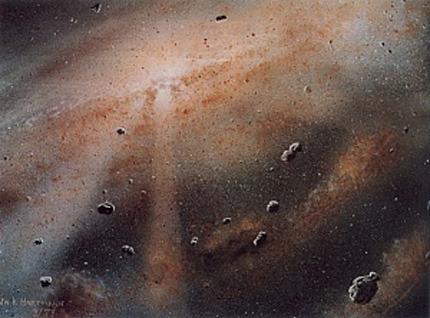 Roughly five billion years ago, a giant molecular cloud some 65 light years in diameter collapsed inward, probably as the result of a nearby supernova. The shockwave from a dying star passed through the nebula, compressing it, changing its density and causing it to collapse. As a the molecular cloud, composed almost entirely of hydrogen and helium, fell in on itself, the conservation of angular momentum caused the gas to swirl and spin, slowly forming a disc, the heart of which would become our sun.
Roughly five billion years ago, a giant molecular cloud some 65 light years in diameter collapsed inward, probably as the result of a nearby supernova. The shockwave from a dying star passed through the nebula, compressing it, changing its density and causing it to collapse. As a the molecular cloud, composed almost entirely of hydrogen and helium, fell in on itself, the conservation of angular momentum caused the gas to swirl and spin, slowly forming a disc, the heart of which would become our sun.
Distinct planets formed 4.6 billion years ago, after the slow, steady, clumping of material accumulated into gravitationally significant objects. But Earth was a hellish, seething mass of volcanic activity, constantly being bombarded by gigantic asteroids. Current thinking is that the Moon was formed within a hundred million years of Earth, as the result of a collision with another planet roughly the size of Mars.
For the next five hundred million years, the Earth cooled as oceans formed and the atmosphere increased in density as the result of volcanic out-gassing.
Life arose on Earth almost as soon as the planet had cooled, before Earth’s protective magnetic field had formed at around 3.5 billion years. That life arose while the planet was subject to a late-heavy bombardment of asteroids from space is surprising, especially as scientists are now considering evidence that suggests this bombardment lasted long than they initially thought, until around 3.8 billions years ago. Given that the oldest fossil records, dating from 3.5 to 3.8 billion years ago, are already quite advanced, scientists speculate that the simplest self-replicating molecules arose around the 4 billion year mark. This is astoundingly quick when you consider how hostile the environment was at that time. The subject of abiogenesis, or how life arose from inorganic molecules is one of the last, great frontiers of modern science.
Abiogenesis is remarkable given the Late Heavy Bombardment of asteroids pummelled the Earth with what should have been killer blows that sterilized the planet time and again. During the bombardment, it is estimated that there were:
22,000 or more impact craters with diameters up to 20 km (12 miles)
about 40 impact basins with diameters about 1,000 km (620 miles)
several impact basins with diameter about 5,000 km (3,100 miles)
The Chicxulub impact, that is thought to have contributed to the demise of the vast majority of dinosaurs some 65 million years ago, left a crater 180 km (110 miles) in diameter, making it comparable to a moderate/modest impact during the Late Heavy Bombardment.
 Given the sheer number of impacts during the bombardment, the question arises, how did life survive in its infancy? And this brings up the contentious and somewhat speculative notion of panspermia. Rather than decimating the fragile beginnings of life, the bombardment may have delivered life to Earth in the first place.
Given the sheer number of impacts during the bombardment, the question arises, how did life survive in its infancy? And this brings up the contentious and somewhat speculative notion of panspermia. Rather than decimating the fragile beginnings of life, the bombardment may have delivered life to Earth in the first place.
Panspermia is the theory that life need not arise on planets like Earth, but that it may be spread, either naturally, deliberately or accidentally through out the universe. Although it should be noted that panspermia (the spread of seeds) doesn’t answer the question of abiogenesis, it simply pushes it out to be resolved at some other time/place.
There’s a number of good objections to the idea of panspermia, or life on Earth arising from space, like the vast distances between planets, let alone between stars, and the sheer amount of energy required to propel matter from one star to another, escaping gravity wells, etc. And yet we find meteorites on Earth that originated on Mars. The reverse journey is not quite as likely, but it is possible.
Don’t underestimate microbes or the importance of microbial life. Without them, there would be no life on Earth.
Space may be a harsh and unforgiving environment for Homo sapiens, bringing death within seconds, causing our blood to boil as the pressure drop allows gases to come out of suspension, but this isn’t the case for microscopic life. In fact, the opposite is true. Exposure to space preserves microscopic life!
In 1967, NASA landed Surveyor 3 on the Moon. Two and a half years later, Apollo 12 touched down next to Surveyor to retrieve the camera so scientists could examine the effects of prolonged exposure to the harsh temperature extremes and radiation in space. To their surprise, scientists found life! Not extraterrestrial life, but microbes that had originated on Earth. Although there’s some conjecture that the analysis of the camera may have inadvertently introduced the contamination after the camera had been returned to Earth, NASA still stands by its original finding, that the contamination was present before launch, enjoyed a holiday on the lunar surface, and was subsequently revived when returned to Earth.
Even if the Surveyor contamination is discredited, there is a certified experiment using tardigrades that demonstrates that complex microbes can survive in space. Well, survive may be too strong a term. A better description would be that microbes can be freeze-dried and revived.
Tardigrades, or water bears, are remarkable examples of the resilience of microscopic life. Barely a millimetre in length, they’re prolific on Earth, being found everywhere from the frigid Arctic oceans, to the tropics and even the Himalayas.
Tardigrades been found living in environments as cold as -80C and can survive an almost complete loss of body water, entering a state called cryptobiosis where their metabolism drops to 0.01% of its normal functioning level, with its body fluids dropping 1% of normal. Although the animal is effectively dead through extreme dehydration, it’s a case of “just add water,” and within a few hours the water bear is alive again. It’s the microscopic equivalent of reviving an Egyptian mummy.
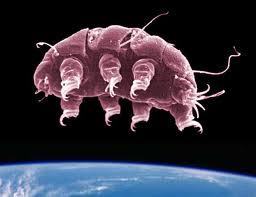 While in a cryptobiotic state, tardigrades can withstand temperatures of -270C and heat of 150C, that’s a viable span of 420 degree Celsius, from almost absolute zero right up to temperatures that would scorch most living cells.
While in a cryptobiotic state, tardigrades can withstand temperatures of -270C and heat of 150C, that’s a viable span of 420 degree Celsius, from almost absolute zero right up to temperatures that would scorch most living cells.
It’s no wonder, then, that NASA sent Tardigrades into space for 10 days in 2007, unprotected from the harsh effects of vacuum and solar radiation, and the water bears took it in their stride, coming back to life once they’d returned to Earth.
Although there’s a huge difference between surviving for a week in space and being blasted off the face of the planet by a meteorite, floating through space for tens of thousands to millions of years before crashing into Mars or one of the moons of Jupiter, in theory, Tardigrades or their eggs could survive such a journey and find themselves revived on contact with liquid water. Whether they could thrive in those new environs is debatable, but that such a notion is in anyway possible lends credence to the idea of panspermia.
 If life on Earth arose as the result of panspermia from that original molecular cloud some five billion years ago, arriving during the Late Heavy Bombardment, then we are confirmation of life on other planets!
If life on Earth arose as the result of panspermia from that original molecular cloud some five billion years ago, arriving during the Late Heavy Bombardment, then we are confirmation of life on other planets!
Our solar system covers roughly a light-day in diameter, while there are approximately 1400 other star systems within 50 light years of Earth.
This image of the Orion nebula spans 24 light years. The molecular cloud from which our system was formed spanned 65 light years, meaning it encompassed such a vast volume of space that panspermia from any one of hundreds of other systems would be plausible.
Panspermia, though, wouldn’t mean aliens would look like us. We share various elements of DNA/RNA with every other living organism on the planet, but the vast majority of them look nothing like us. We may, however, be the descendants of freeze-dried bugs.
_________
UPDATE: Although panspermia is entirely speculative, comets and objects in the Kuiper Belt give us the opportunity to study the kind of asteroids/comets that made up the Late Heavy Bombardment that “might” have seeded Earth. So far, spectroscopy has detected methane in the belt, while amino acids have been found in comets. Perhaps one day we’ll find a primitive, overly simplistic RNA molecule that’s capable of self-replication, and that may be the precursor to life on Earth.


September 16, 2012
Aliens among us
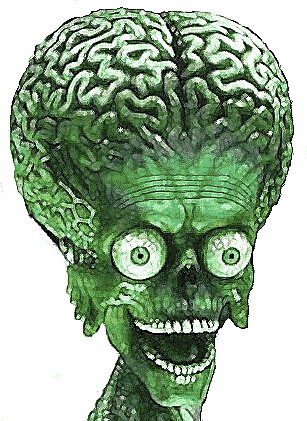 Forget about going to the movies to understand what a real alien might look like, as the Hollywood kind are generally just men in play-suits or a bit of computer-generated special effects. If you want to see something really “alien” go for a walk in a forest, down by a lake, or along the sea shore, and look at the astounding diversity of life here on Earth. Much of it defies the imagination of the best science fiction writers.
Forget about going to the movies to understand what a real alien might look like, as the Hollywood kind are generally just men in play-suits or a bit of computer-generated special effects. If you want to see something really “alien” go for a walk in a forest, down by a lake, or along the sea shore, and look at the astounding diversity of life here on Earth. Much of it defies the imagination of the best science fiction writers.
As a science fiction writer, I enjoy thinking conceptually about the various forms in which alien life may exist. It’s not a case of trying to come up with creatures that have an absurd number of arms or a something weird and implausible, like a star-whale, rather it’s an attempt to consider how life could evolve in different environs and to consider how we might interact with any alien intelligence.
And it’s not all death rays and anal probes, there has to be rational, reasonable, plausible motivations behind the actions of any intelligent being, human or alien. If an alien space craft ever does arrive on our front door step, the single most likely reason for it to turn up would be exploration, not exploitation.
The most precious commodity in the universe is life itself. Any visiting aliens are going to want to understand how our evolutionary past led to our current biodiversity, so rather than finding them hovering over the White House with a laser beam poised to fire, you’re more likely to find them in universities and museums, perhaps even helping out on a dinosaur dig.
One thing that’s missing from almost all alien movies is an ecosystem. Aliens, as Hollywood portrays them, are only ever shown as a single species. For all its faults, the movie Prometheus is one of the few movies that had several variants of alien life, one of which eventually transforms into something vaguely like the critters Ripley runs into. In reality, though, aliens will evolve in an ecosystem that’s at least as complex and diverse as our own, with as many of the subtleties and surprises as we find on Earth. In this regard, the best way to understand alien life before we come across any actual examples is to better understand our own biosphere.
Although we have no idea what aliens look like, we can be reasonably certain they won’t look anything like us. Good science fiction writers try to escape the regular, predictable alien-tropes, where aliens are bipeds roughly the size of a man or slightly larger and more imposing, having arms and legs along with a clearly recognizable head with two eyes and a mouth, etc. There certainly could be some convergent evolution in our celestial neighbours, but given the extreme diversity of life on Earth, any similarities are probably going to be quite fleeting. Life on Earth demonstrates that an astounding array of differences are possible.
 What could be more “alien” to us than an octopus, or the zombie-like sea squirt that eats its own brains? And an octopus is more than just some squidgy alien-esque invertebrate with eight flexible arms, those arms think for themselves, being semi-autonomous, with their own ganglia. Essentially, an octopus is a living neural network with a central brain that issues orders to the arms and then leaves them to get the job done while it moves on to think about something else. Quite a marvellous adaptation, and this highlights something missing from movies. In movies, aliens are visibly distinct and different to humans, even if it’s only by a set of pointy ears. In reality, the physiology of aliens is going to be vastly different to that of Homo sapiens, from the microscopic layer on up through to morphology. They may well have “brains” that are sooo distributed that there’s no one central point at all, extending the kind of adaptation we see in the octopus even further.
What could be more “alien” to us than an octopus, or the zombie-like sea squirt that eats its own brains? And an octopus is more than just some squidgy alien-esque invertebrate with eight flexible arms, those arms think for themselves, being semi-autonomous, with their own ganglia. Essentially, an octopus is a living neural network with a central brain that issues orders to the arms and then leaves them to get the job done while it moves on to think about something else. Quite a marvellous adaptation, and this highlights something missing from movies. In movies, aliens are visibly distinct and different to humans, even if it’s only by a set of pointy ears. In reality, the physiology of aliens is going to be vastly different to that of Homo sapiens, from the microscopic layer on up through to morphology. They may well have “brains” that are sooo distributed that there’s no one central point at all, extending the kind of adaptation we see in the octopus even further.
It’s all speculation, of course, but speculation based on the rudiments of life we see around us and not just on our imagination.
 Octopus and cuttlefish are remarkably intelligent, being capable of negotiating a maze, solving puzzles and opening screw-top jars. One of the earliest observations of their intelligence is a curious tale where lump fish kept disappearing from an isolated tank within an aquarium in England. It took the curators a while to figure out the thief was an octopus, climbing out of his tank at night, crossing the floor, entering the second tank, devouring the fish, and then surreptitiously returning to his own tank by morning!
Octopus and cuttlefish are remarkably intelligent, being capable of negotiating a maze, solving puzzles and opening screw-top jars. One of the earliest observations of their intelligence is a curious tale where lump fish kept disappearing from an isolated tank within an aquarium in England. It took the curators a while to figure out the thief was an octopus, climbing out of his tank at night, crossing the floor, entering the second tank, devouring the fish, and then surreptitiously returning to his own tank by morning!
Cuttlefish have the most beautiful form of communication, transmitting vacillating/undulating waves of light to each other to signal danger, courtship, etc in a visual form of speech, highlighting how different terrestrial animals are in their forms of communication. If we run into ET, it’s highly unlikely we’ll be able to chat audibly with them as speech may well be as peculiar to aliens as cuttlefish flashes are to us.
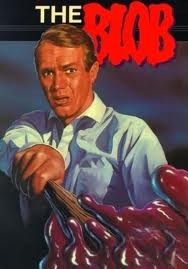 Like something out of The Blob, slime are another example of how “alien” life on Earth can be when compared with our normal assumptions on the nature of microscopic life. Slime give us a unique insight into how even the simplest lifeforms can have remarkable complexity.
Like something out of The Blob, slime are another example of how “alien” life on Earth can be when compared with our normal assumptions on the nature of microscopic life. Slime give us a unique insight into how even the simplest lifeforms can have remarkable complexity.
Place an oak flake in the middle of a maze and Physarum polycephalum will find it for you, using the shortest path through the maze, simply by following the chemical attractants given off by the oats as a food source.
If you place slime mold on a map of Japan or the US and place food where the various cities are and let the slime mold spread out across landscape, Physarum polycephalum will optimize the network, consolidating on the best routes between food sources, essentially replicating the actual transit map designed by human engineers.

And it gets better… Give mold a choice and its “decisions” become deceptively human-like.
Physarum polycephalum doesn’t thrive in bright light. In one experiment, researches gave Physarum polycephalum two food choices: 3% mix of oats in darkness or 5% mix of oats in bright light. The mold spread out, taking nutrients from both sources equally even though the richer source was more irritating to the mold. There’s nothing too remarkable about that, but scientists then introduced a third food source: 1% mix of oats in darkness.
Surprisingly, with three choices, the mold made what seems like a comparative decision, and instead of being split between the 3% in darkness and 5% in light as it had previously been, the mold devoted 80% of its effort solely on the 3% in darkness. The introduction of a poorer option allowed the mold to “realize” the best option all along had been the 3% in darkness. Going after the 5% was too costly for the mold, but the slime only came to this point of “realization” when given sufficient comparative options. This illusion of a decision is the result of a biological comparison where the best return/result is unthinkingly sought out by the organism, but that a colony of amoeba could replicate the reasoning of a creature with a brain is quite remarkable, demonstrating the tenacity and versatility of even the simplest of lifeforms.
Dictyostelium Discoideum are even more astounding, starve this colony of single-celled amoeba and they’ll do something beyond belief, they’ll band together to form a giant slug.

And Dictyostelium Discoideum aren’t just huddling together like rugby players in a scrum, they’re differentiating, taking on set roles within their pseudo-slug, with some of the amoebas playing the role of an immune system, policing the newly formed organism for any bacteria or pathogens, attacking them so the newly formed “slug” can live. The slug, in the meantime, takes on a life of its own, searching for light. In this video, it can be seen moving, lifting itself from the surface of the petri dish, and finally transforming itself yet again, this time into a fruiting spore at the end of a raised stem. Like the polymorph in Red Dwarf, if we find even the simplest of alien lifeforms on the moons of Europa, Encleadus or Titan, they may well have this kind of chameleon ability.
Life is astounding. There’s only a handful of science fiction books or movies that come close to anticipating anything like the versatility and interconnectedness we observe in Nature, and yet if life has arisen on other worlds, it will have followed the same basic laws of Natural Selection, so there will be similar levels of adaptation to common challenges. As a science fiction writer, this challenges me to think deeper about the kind of life we might find on other worlds.
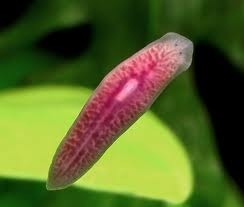 Planarians are another example of the unpredictability of life. These simple flat-worms are hunters with a difference, with their pharynx/mouths secreting digestive fluids before eating their prey, only their mouth also doubles as an anus. Although they have brains, eyes and complex body organs, you can slice and dice a single planarian into hundreds of sections and they’ll all rejuvenate into entirely new planarians. In one simple creature, there’s a level of sophistication and versatility science fiction writers struggle to emulate when imagining alien life forms.
Planarians are another example of the unpredictability of life. These simple flat-worms are hunters with a difference, with their pharynx/mouths secreting digestive fluids before eating their prey, only their mouth also doubles as an anus. Although they have brains, eyes and complex body organs, you can slice and dice a single planarian into hundreds of sections and they’ll all rejuvenate into entirely new planarians. In one simple creature, there’s a level of sophistication and versatility science fiction writers struggle to emulate when imagining alien life forms.
Life on Earth never ceases to amaze me. From a gecko climbing a wall utilizing the Van Der Walls nuclear force without ever realizing it, to bats locating insects on the wind with sonar they never consciously built, it seems there’s no limit to how evolution has honed life on our humble little planet. If we find life on Mars, Europa, Titan or Encaledus, there’s one thing for sure, it will surprise us with its versatility and resourcefulness.


September 12, 2012
Gravity Sucks
 Recently, Jupiter was hit by a comet/asteroid that would have made the Chicxulub impact that wiped out the dinosaurs look like a pebble landing in a pond.
Recently, Jupiter was hit by a comet/asteroid that would have made the Chicxulub impact that wiped out the dinosaurs look like a pebble landing in a pond.
In talking about this with a colleague, the concept of gravitational wells came up, in particular the concept that Jupiter acts as a vacuum cleaner in our solar system, mopping up debris and protecting life on Earth from big impacts. In fact, a Jupiter-like planet may be a prerequisite for life elsewhere in the universe; think of Jupiter as a celestial bouncer making sure no one gate-crashes the party.
To help visualise this, I thought it would be fun to post a blog about what it would be like to wear a pair of “gravitational lenses” and see the solar system from a gravitational perspective.
If you think about Earth and what it looks like from space, you probably get a mind picture similar to the image above, but, from a gravitational perspective, the Earth isn’t quite so uniform and pretty, looking a bit more like something out of the Hunchback of Notre Dame.
The distortions in this image have been exaggerated, but they highlight the different gravitational variations found on Earth. These variations arise from differences in the thickness and composition of Earth’s crust, as well as how plates move relative to each other, subduction zones, the rise of mountains, depths of the sea, etc.
To complicate things further, the gravitational profile of Earth isn’t static as the Sun and Moon also play a part, flexing not only the tides in the sea, but the Earth’s crust as well. Remarkably, the gravitational attraction of the Moon causes the Earth’s crust to rise up to a foot along with high tides.
Space is unimaginably big, so much so we tend to underestimate just how vast distances are in space. We have no terrestrial basis for comparison, making the orders of magnitude difficult to comprehend when thinking about Earth, the Moon, Mars, our solar system, local stars, the Milky Way and the universe as a whole. Putting a man on Mars, as an example, seems easy. We put rovers there all the time. We put men on the Moon forty years ago. How hard can it be to get men and women to Mars? And the answer is, it is absurdly difficult. Getting to Mars isn’t just a matter of willpower, there are serious technical and logistical challenges in operating at that distance. NASA recently likened the Curiosity landing to hitting a golf ball from Los Angeles and achieving a hole in one in Scotland. Don’t underestimate just how incredible it is that Curiosity is driving around Gale Crater. It’s a technical feat beyond that of Stonehenge or the Pyramids.
Every pretty picture you’ve seen of the solar system is grossly distorted by non-linear scaling, and this one is no exception.
If we use a bowling ball to represent the Sun, then you’ll find the planets at the following distances from the bowling ball:
Mercury – a pin-head some 9 meters away
Venus – a peppercorn at 17 meters
Earth – another peppercorn at 24 meters
Mars – a pin-head at 36 meters
Jupiter – a golf ball or Macadamia nut in its shell set out at 120 meters
Saturn – a Macadamia kernel at 225 meters
Uranus – a coffee bean at 453 meters
Neptune – another coffee bean at just over 700 meters
Pluto – a full-stop at just over 900 meters
In between and all around there’s an awful lot of empty space. Well, “empty” is a misnomer, but there’s nothing of any substance beyond a wispy vacuum with highly energetic particles, electromagnetic radiation and the odd rock or stray clump of ice.
We tend to think of the solar system as flat because the planets orbit (mostly) on the same plane, being formed from an accretion disc billions of years ago, but, if we look at the gravitational distortion of the sun and planets we get a very different picture.
This representation of the gravitational wells surrounding the Sun and Jupiter gives us an entirely different view of space, dispelling the notion that space is flat. By the way, the spike in front of the Jupiter well is a Lagrange point, a gravitationally neutral point, where the strength of both gravity wells is effectively cancelled out.
It’s this gravity well surrounding our Macadamia-nut-Jupiter that vacuums up most of the debris that would devastate life on Earth.
XKCD put together the following infographic that highlights, among other things, why the Apollo mission to the moon required a huge Saturn V rocket one way, but only a small rocket for the return journey. (Click on the image to enlarge it and make it easier to read)
Dam “plugholes” are a good example of how a gravity well works, with the currents and the flow of water from all around a dam being influenced in one way or the other by the drain. Get too close and down you go.

In my novel Galactic Exploration the star ship Rift Valley encounters sinister aliens in a dense star cluster and uses the complex gravitational wells and Lagrange points to sail through the cluster as the crew try to escape their pursuers. From a gravitational perspective, the star cluster would have looked something like this, with each of the stars and super-jupiter planets being the long spikes reaching downward.



September 7, 2012
Martian Geology 101
Mt Sharp (Aeolis Mons) is a geologist’s dream. Following on from a recent post, Why Gale Crater, I thought it would be interesting to examine this photo by Curiosity from within Gale Crater, looking at the Mons.
The numbers on this image show the distance from the rover as it looks out across the valley within the crater at Aeolis Mons. The small inset image is of a large rock, roughly the size of the Mars Curiosity Rover, some nine kilometres (roughly 5.5 miles) away, allowing us to gain some perspective on size. The triangular, pointy mound this rock sits in front of is approximately 300 meters (1000 feet) across and 100 meters (300 feet) high.
This image shows sedimentary layers spanning several billion years of history on Mars. Look at the beautifully delineated layers or strata on the Mons. Each layer accumulated over tens to hundreds of millions of years before being eroded away by the Martian weather, leaving the view we see today.
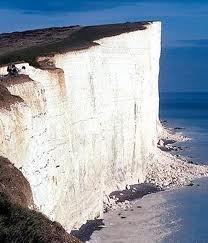 On Earth, we find fossil beds captured chronologically in sedimentary layers that are then exposed by the kind of weathering we see on Mars. That’s not to say we’ll find fossils on Mars, but if life has existed in other Martian epochs, this is where we are most likely to find it.
On Earth, we find fossil beds captured chronologically in sedimentary layers that are then exposed by the kind of weathering we see on Mars. That’s not to say we’ll find fossils on Mars, but if life has existed in other Martian epochs, this is where we are most likely to find it.
Not only do geological features on Earth contain fossils, some of them are comprised almost entirely of fossils, like the White Cliffs of Dover. These magnificent cliffs are the fossilized remains of prehistoric single-celled algae which decayed to form chalk a hundred million years ago during the Cretaceous period. At upwards of a hundred meters in height, these cliffs represent the gradual accumulation of sediment over roughly 35 million years.
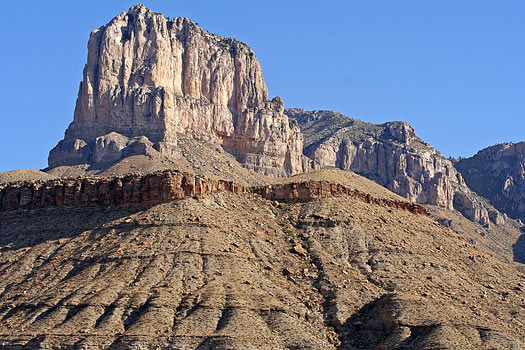 In Texas, the Capitan mountains in Guadeloupe National Park are another fascinating example of how radically landscapes can change over immense geological time periods.
In Texas, the Capitan mountains in Guadeloupe National Park are another fascinating example of how radically landscapes can change over immense geological time periods.
Somewhat counter-intuitively, this prominent mountain is the remains of a submerged reef dating back to the Permian era, some three hundred million years ago. If these kind of transformations are possible on Earth, imagine what has happened on Mars over the same span of time.
Looking at our image from Curiosity, the 10 kilometre mark on Mount Sharp reveals several contrasting layers, thick dark bands separate several lighter strata, marking vastly different types of rock. This suggests significant differences in the prevailing climatic conditions over millions of years during their formation. Mount Sharp is a time machine, revealing the history of Mars in distinct epochs, showing how the planet has been radically reshaped over time. Mars is anything but static like the Moon. To look at Mars as a cold, dry, dusty, lifeless desert is a gross oversimplification.
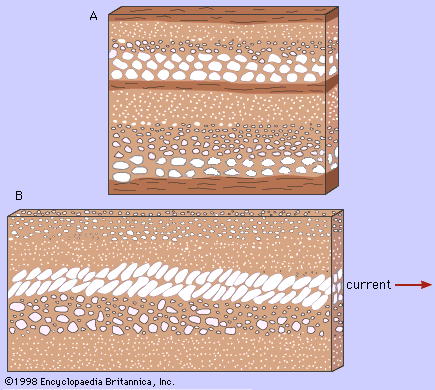 One thing NASA will be looking for with Curiosity is graded bedding. If there are several layers of progressively graded rocks, from large to small, then from large to small again, we can be confident these layers were deposited in water at different times, where the coarse stones settle below the fine grains time and again, perhaps during major floods separated by dry periods.
One thing NASA will be looking for with Curiosity is graded bedding. If there are several layers of progressively graded rocks, from large to small, then from large to small again, we can be confident these layers were deposited in water at different times, where the coarse stones settle below the fine grains time and again, perhaps during major floods separated by dry periods.
Sedimentary systems are, by definition, built by the flow of material from highlands to low. They are normally carried by liquid, but the wind can play a part as well.
In the case of Mt Sharp, the lowest areas you can see in this photograph are the oldest sedimentary layers, but they’re buried by recent erosion. The higher, relatively more recent layers are still hundreds of millions to billions of years old, as it would take considerable time for all of these layers to have formed, then to have eroded away to reveal the landscape we see today.
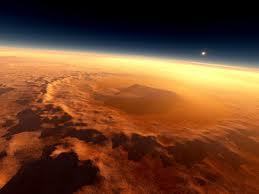 Looking at Mount Sharp, it is interesting to note that the layers visible in this image are all parallel, meaning in this local area at least, there has not been any of the tectonic upheaval we see on Earth. Given the lack of a major satellite flexing the Martian crust like Earth’s moon, this is not surprising.
Looking at Mount Sharp, it is interesting to note that the layers visible in this image are all parallel, meaning in this local area at least, there has not been any of the tectonic upheaval we see on Earth. Given the lack of a major satellite flexing the Martian crust like Earth’s moon, this is not surprising.
Serious consideration has been given to Valles Marineris, the Grand Canyon of the Solar System, being the result of tectonic activity, but there are no plate boundaries, making this unlikely. There are also theories that describe both the Valles Marineris and the Tharsis Uplift as being the indirect result of the impact that formed the Hellas basin, but that’s a fascinating discussion for another post.
Geology is more than just the study of rocks, it is the study of history on the grandest of scales, and how history has been written into the very rocks of a planet. On Earth, rocks record the chronological impact of life on the planet, perhaps the same is true of Mars. With Curiosity on the ground, Martian geology has been given a whole new impetus. The results of this exploration are sure to be enlightening.


Anomaly v1.5 [Book Review x2]
 Reblogged from 88 mph to Roswell:
Reblogged from 88 mph to Roswell:

Nearly a year ago author Peter Cawdron took and dropped a gem on the indie book scene with Anomaly. The story of an under-achieving teacher who goes from field trip spectator in downtown NYC to over-achieving armchair scientist in the blink of an eye and thrusting himself into the biggest moment in human history, first contact.
WARNING! SPOILERS BELOW.
In January of this year I read and reviewed this story…
This re-blog is a review of the revised ending to my novel Anomaly. If you read the old version with the UN invasion and would like to compare that to the new version, simply remove the book from your Kindle, and download a new copy using the "Cloud" category on your device. Jump in around chpt 16.
August 25, 2012
Farewell, Neil Armstrong
We are, by nature, competitive and somewhat obsessed by firsts. Whether it is Olympic gold, the first man in space, the first man on the moon or the first person to climb Everest, to be first is culturally a crowning achievement.
Somewhat ironically, though, those that have been “first” are among the few who see through this illusion. When asked who first stepped foot on the summit of Mt Everest, Sir Edmund Hillary refused to answer, noting it was a joint-effort, that he could not have accomplished the feat without Tenzing Norgay. Expedition leader, Colonel Hunt, also noted, “They reached it together, as a team.” In the same way, Neil Armstrong shunned the notion that he was “the first man on the moon” or the “first man to walk on the moon” noting that whether it was the thin hull of the Eagle or the rubber sole of their boots, neither man actually touched the moon. Both Neil and Buzz landed in the Sea of Tranquillity at the same time. They were the first men on the moon.
Although Neil and Buzz ventured down to the moon in the Eagle, Armstrong, Aldrin and Collins and a whole host of other astronauts all put their lives in jeopardy for the sake of human exploration, to further our scientific knowledge of the moon and man’s ability to explore space. This in no way detracts from Neil Armstrong’s accomplishment as commander of the mission, but it puts it in a perspective he himself endorsed, that the lunar landing was a team effort.
When it comes to the actual landing, flight analyst Morris Jones notes.
Other astronauts could have landed but he was really the best choice and sometimes I think without him they wouldn’t have landed on that attempt. They would have got home safely but probably would have had to abort the landing and try again. Armstrong played a critical role in making that landing succeed.
Neil Armstrong’s heart was racing at 150 beats per minute as he sought to land the Eagle clear of a boulder field in the Sea of Tranquillity. Neil and Buzz sounded unusually calm during the descent, their professionalism taking priority over their nerves as the fuel gauge within the Eagle ran to empty. They touched down with just seconds to spare, making history as the first men to visit another celestial world.
Armstrong, Aldrin and Collins were at the tip of the most remarkable scientific technological endeavour in the history of mankind, the culmination of tens of thousands of scientists and engineers working together toward a goal that was decades ahead of its time. It took a remarkable amount of courage to strap into a Saturn V rocket built using slide-rules, pen and paper and a computer system that pales in comparison to today’s mobile phones.
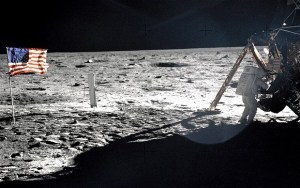 Neil Armstrong will be remembered as the lead in this outstanding accomplishment, and for his historic comment, “That’s one small step for man, one giant leap for mankind.” These eleven, brief words capture the essence of Apollo.
Neil Armstrong will be remembered as the lead in this outstanding accomplishment, and for his historic comment, “That’s one small step for man, one giant leap for mankind.” These eleven, brief words capture the essence of Apollo.
Although critics would note that NASA has not repeated the achievements of its glory days, I’d argue that the critics are wrong, that they’re looking at US space accomplishments from only one, narrow perspective.
I would rate the launch of Pioneer and Voyager, the advent of commercial satellites, the establishment of SETI, the reach of Viking, WMAP, the Allen array, the Hubble space telescope, the Curiosity mission to Mars, Cassini, the proposed James Webb telescope, etc, as extending mankind’s giant leap. In fact, I’d struggle to find a single space exploration project, either by NASA, the Chinese, the Russians or private enterprise that hasn’t made a significant contribution to mankind’s progress in space. Perhaps they’re not as epic as Armstrong and Aldrin walking on the moon for the first time, perhaps some of them are more incremental, but they all take us forward into a new phase in the history of mankind, the space age.
I’m thankful for men and women like Armstrong, Aldrin and Collins who have pushed back the bounds of the unknown, who reached out to explore and understand the cosmos. Be it a computer server crunching radio telescope results in the basement at SETI or a rover sitting on Mars, be it man walking again on the moon or SpaceX launching commercial resupply for the International Space Station, we are continuing to step forward into a bold, new future. Neil Armstrong’s one small step continues to inspire mankind to leap forward.
Rest in peace, Neil.





























